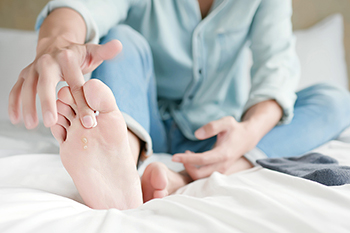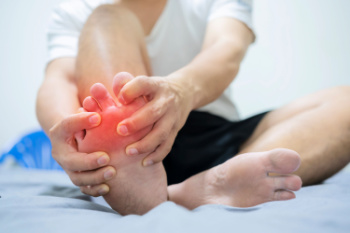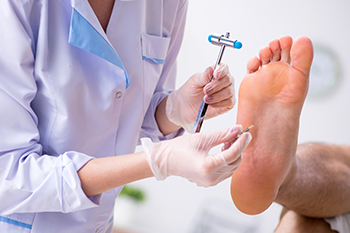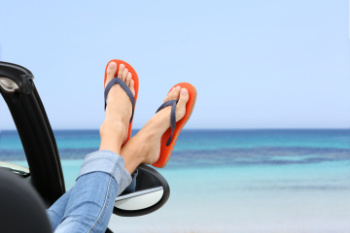March 2024
Causes and Symptoms of Athlete’s Foot

Athlete's foot, also known as tinea pedis, is a common fungal infection of the foot caused by dermatophytes. This infection thrives in warm, moist environments and is often the result of coming into contact with contaminated surfaces, like locker room floors. Symptoms include scaling, peeling skin, and redness between the toes. Other symptoms of athlete’s foot are blistering and itching. If left untreated, athlete's foot can lead to secondary bacterial infections or allergic reactions, particularly in individuals with a compromised immune system or diabetes. Prevention involves maintaining good foot hygiene, wearing breathable footwear, and avoiding sharing personal items, like shoes or towels. If you suspect you have athlete's foot or experience severe symptoms like excessive redness, swelling, or pus, it's essential to seek prompt medical attention from a podiatrist. A podiatrist can provide an accurate diagnosis and recommend an advanced treatment plan to alleviate complications. For help in dealing with a stubborn athlete’s foot infection, It is suggested that you make an appointment with a podiatrist.
Athlete’s foot is an inconvenient condition that can be easily reduced with the proper treatment. If you have any concerns about your feet and ankles, contact Dawn Miles, DPM from Florida. Our doctor will treat your foot and ankle needs.
Athlete’s Foot: The Sole Story
Athlete's foot, also known as tinea pedis, can be an extremely contagious foot infection. It is commonly contracted in public changing areas and bathrooms, dormitory style living quarters, around locker rooms and public swimming pools, or anywhere your feet often come into contact with other people.
Solutions to Combat Athlete’s Foot
- Hydrate your feet by using lotion
- Exfoliate
- Buff off nails
- Use of anti-fungal products
- Examine your feet and visit your doctor if any suspicious blisters or cuts develop
Athlete’s foot can cause many irritating symptoms such as dry and flaking skin, itching, and redness. Some more severe symptoms can include bleeding and cracked skin, intense itching and burning, and even pain when walking. In the worst cases, Athlete’s foot can cause blistering as well. Speak to your podiatrist for a better understanding of the different causes of Athlete’s foot, as well as help in determining which treatment options are best for you.
If you have any questions please feel free to contact one of our offices located in Palatka and Saint Augustine, FL . We offer the newest diagnostic and treatment technologies for all your foot and ankle needs.
What Is Ainhum and How Podiatrists Can Help?

Ainhum is a rare condition characterized by the spontaneous development of a constricting band around the base of the fifth toe. This can lead to progressive constriction, tissue loss, and eventual auto-amputation if left untreated. Podiatrists play a vital role in diagnosing and managing ainhum. They can provide early intervention by carefully monitoring the condition and relieving pressure on the affected toe. These foot doctors can offer treatments, such as surgical release of the constricting band or orthotic devices to alleviate discomfort and prevent further tissue damage. Podiatrists also can educate patients about proper foot care techniques and regular monitoring to detect any changes in the condition early on. If you notice a ring around one of your toes with a squeezing sensation, it is strongly suggested that you make an appointment with a podiatrist for a timely diagnosis and immediate treatment.
Some foot conditions may require additional professional care. If you have any concerns, contact Dawn Miles, DPM of Florida. Our doctor can provide the care you need to keep you pain-free and on your feet.
Rare Foot Conditions
The majority of foot conditions are common and can be treated by a podiatrist. Standard diagnostic procedures are generally used to identify specific conditions and treatment can be rendered. A podiatrist also treats rare foot conditions which can be difficult to diagnose and may need extra attention and care.
There are many rare foot conditions that can affect children. Some of these can include:
- Freiberg’s disease
- Kohler’s disease
- Maffucci syndrome
Freiberg’s disease - This can be seen as a deterioration and flattening of a metatarsal bone that exists in the ball of the foot. It typically affects pre-teen and teenage girls, but can affect anyone at any age. Symptoms that can accompany this can be swelling, stiffness, and the patient may limp.
Kohler’s disease - This often targets the bone in the arch of the foot and affects younger boys. It can lead to an interruption of the blood supply which ultimately can lead to bone deterioration. The patient may limp or experience tenderness, swelling, and redness.
Maffucci syndrome - This affects the long bones in a child’s foot leading to the development of abnormal bone lesions. They are benign growths and typically develop in early childhood and the bones may be susceptible to breaking.
A podiatrist can properly diagnose and treat all types of rare foot conditions. If your child is affected by any of these symptoms or conditions, please don’t hesitate to call our office so the correct treatment method can begin.
If you have any questions please feel free to contact one of our offices located in Palatka and Saint Augustine, FL . We offer the newest diagnostic tools and technology to treat your foot and ankle needs.
How a Podiatrist Can Help You

Your feet contain one-fourth of the bones in the body, as well as a complex structure of muscles, ligaments, tendons, and joints. It's not uncommon for one or several of these components to be in pain. If you are physically active, the chances of incurring a foot injury or other condition are even higher. It is sometimes necessary to seek medical help from a podiatrist with foot, toe, or ankle pain. Beyond just examining your feet, a podiatrist conducts a thorough assessment of your gait to understand how foot issues might be affecting other parts of your body. With expertise in foot and lower limb structure and movement, a podiatrist can diagnose foot conditions, identify underlying health issues, such as diabetes or arthritis, and tailor treatment plans accordingly. If you're experiencing foot pain, skin or nail abnormalities, foot injuries, or broader health concerns like diabetes, it may be time to visit a podiatrist. Your feet deserve the best care possible. It is suggested that you make an appointment with a podiatrist today to address any foot pain or other related concerns you may have.
If you are dealing with pain in your feet and ankles, you may want to seek help from a podiatrist. Feel free to contact Dawn Miles, DPM from Florida. Our doctor can provide the care you need to keep you pain-free and on your feet.
What Is a Podiatrist?
A podiatrist is a doctor of podiatric medicine who diagnoses and treats conditions of the foot, ankle, and related structures of the leg. Your podiatrist may specialize in a certain field such as sports medicine, wound care, pediatrics, and diabetic care. Podiatrists have the ability to become board certified through training, clinical experience, and then taking an exam.
What Do Podiatrists Do?
On a daily basis, a podiatrist may perform the following activities:
- Diagnose foot ailments such as ulcers, tumors, fractures, etc.
- Use innovative methods to treat conditions
- Use corrective orthotics, casts, and strappings to correct deformities
- Correct walking patterns and balance
- Provide individual consultations to patients
It is very important that you take care of your feet. It’s easy to take having healthy feet for granted, however foot problems tend to be among the most common health conditions. Podiatrists can help diagnose and treat a variety of feet related conditions, so it is crucial that you visit one if you need assistance.
If you have any questions please feel free to contact one of our offices located in Palatka and Saint Augustine, FL . We offer the newest diagnostic and treatment technologies for all your foot and ankle needs.
Foot Pain Caused by Flip-Flops
 While flip-flops are convenient, wearing them can have negative effects on the feet. Most flip-flops lack proper arch support and cushioning. Prolonged use of flip-flops can lead to issues like flat feet, plantar fasciitis, and increased strain on the toes. This is because flip-flops can cause you to put more pressure on the plantar fascia, tissues that run from the toes to the heel. The toes also perform a constant gripping motion to keep flip-flops on, which can cause muscle fatigue and contribute to toe deformities. Additionally, the minimal protection flip-flops offer the feet leave them exposed to the elements, increasing the risk of injuries, sunburn, and infections. If you are experiencing foot pain from wearing flip-flops, it is suggested you schedule an appointment with a podiatrist who can rule out any other causes and discuss alternative footwear.
While flip-flops are convenient, wearing them can have negative effects on the feet. Most flip-flops lack proper arch support and cushioning. Prolonged use of flip-flops can lead to issues like flat feet, plantar fasciitis, and increased strain on the toes. This is because flip-flops can cause you to put more pressure on the plantar fascia, tissues that run from the toes to the heel. The toes also perform a constant gripping motion to keep flip-flops on, which can cause muscle fatigue and contribute to toe deformities. Additionally, the minimal protection flip-flops offer the feet leave them exposed to the elements, increasing the risk of injuries, sunburn, and infections. If you are experiencing foot pain from wearing flip-flops, it is suggested you schedule an appointment with a podiatrist who can rule out any other causes and discuss alternative footwear.
Flip-flops can cause a lot of problems for your feet. If you have any concerns about your feet or ankles, contact Dawn Miles, DPM from Florida. Our doctor will assist you with all of your foot and ankle needs.
Flip-Flops and Feet
Flip-flops have managed to become a summer essential for a lot of people. While the shoes may be stylish and easy to slip on and off, they can be dangerous to those who wear them too often. These shoes might protect you from fungal infections such as athlete’s foot, but they can also give you foot pain and sprained ankles if you trip while wearing them.
When Are They Okay to Wear?
Flip-flops should only be worn for very short periods of time. They can help protect your feet in places that are crawling with fungi, such as gym locker rooms. Athlete’s foot and plantar warts are two common fungi that flip-flops may help protect your feet against.
Why Are They Bad for My Feet?
These shoes do not offer any arch support, so they are not ideal for everyday use. They also do not provide shock absorption or heel cushioning which can be problematic for your feet. Additionally, you may suffer from glass cuts, puncture wounds, and stubbed toes since they offer little protection for your feet.
More Reasons Why They Are Bad for Your Feet
- They Slow You Down
- May Cause Blisters and Calluses
- Expose Your Feet to Bacteria
If you have any questions, please feel free to contact one of our offices located in Palatka and Saint Augustine, FL . We offer the newest diagnostic and treatment technologies for all your foot care needs.










